Tiger Lake H looks promising, but benchmarks will ultimately determine the winner of this fight.
Rob Schultz / IDG
Today’s Best Tech Deals
Picked by PCWorld’s Editors
Top Deals On Great Products
Picked by Techconnect’s Editors
AMD’s quest for CPU dominance has expanded in recent years—after first clawing back into relevance with its desktop processors, the company set its sights on laptops. Ryzen 5000 mobile chips dunked on Intel’s Comet Lake H parts, zipping past Team Blue’s best with ease.
With Tuesday’s announcement of Tiger Lake H, Intel may regain ground as an industry leader. Its long-in-the-tooth 14nm process is gone, and with that change comes the promise of notable performance jumps and support for cutting-edge features. As you’ll see in our quick head-to-head comparison with the equivalent H-class Ryzen 5000 chips, this rivalry might become fierce again.
The contenders: Tiger Lake H vs. Ryzen 5000 mobile
Intel’s 11th generation of mobile processors already includes four-core, eight-thread Tiger Lake H35 CPUs, announced during CES 2021 in January. This freshly unveiled set of five Tiger Lake H chips (nicknamed by some as Tiger Lake H45) round out the lineup: Two Core i5, one Core i7, and two Core i9 options feature either six or eight cores with Hyperthreading. The top-tier Core i9 processor can boost to a max of 5GHz on up to two cores. It’s also the lone part with a 65W TDP—the other four chips have a 45W TDP.
These CPUs are based on Intel’s 10nm Willow Cove microarchitecture, and support PCIe 4.0 and Thunderbolt 4. You can read more details on these Tiger Lake H processors in our full rundown of the announcement.
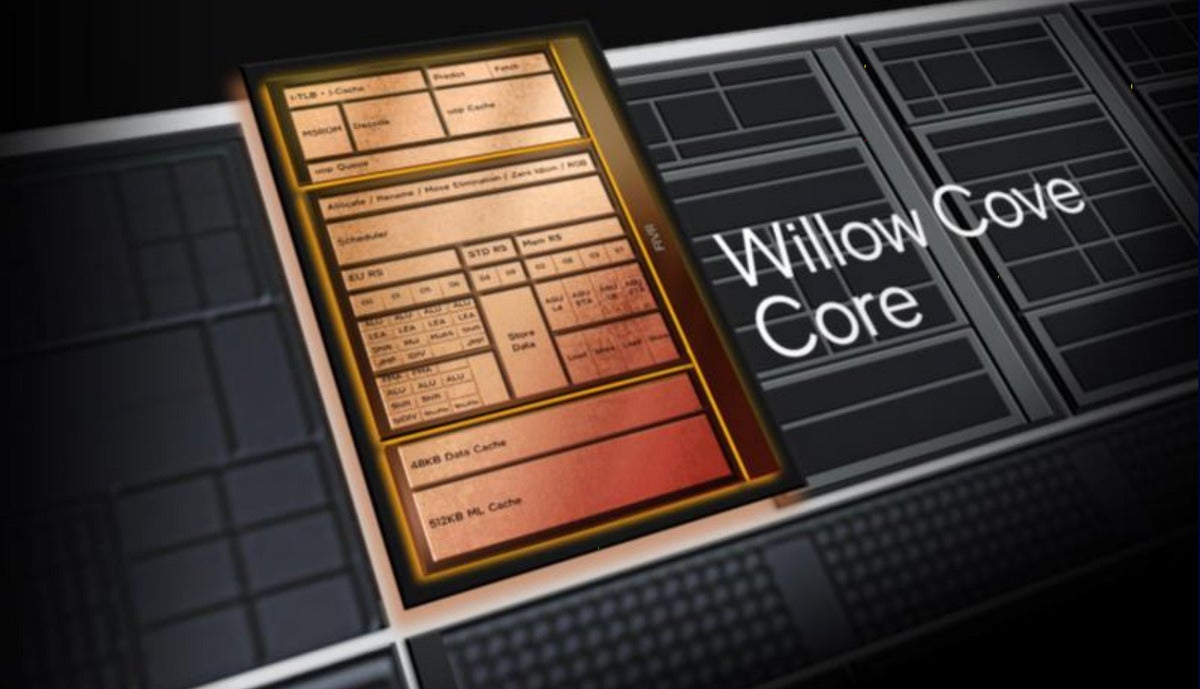 Intel
IntelTiger Lake H processors are based on Intel’s 10nm Willow Cove microarchitecture.
In contrast, Ryzen 5000 mobile processors offer more choice—and a little more complexity. AMD’s competing line of H-class parts launched during CES 2021 with eight processors, all based on the company’s 7nm Zen 3 microarchitecture. This lineup of laptop CPUs is weighted toward the high end, with two mid-range Ryzen 5 variants with 6 cores and 12 threads, two high-end Ryzen 7 options with 8 cores and 16 threads, and four top-tier Ryzen 9 chips with 8 cores and 16 threads. However, some CPUs are HS models with a lower 35W TDP, while the H versions have a TDP of 45W and the HX processors are listed as 45W+. The HX parts are also overclockable.
Unlike Tiger Lake H, Ryzen 5000 mobile parts do not support PCIe 4.0 nor Thunderbolt 4. (That is a contrast with desktop Ryzen 5000 chips, which do support PCIe 4.0.) You can read more specs and details in our comprehensive overview of Ryzen 5000 mobile processors.
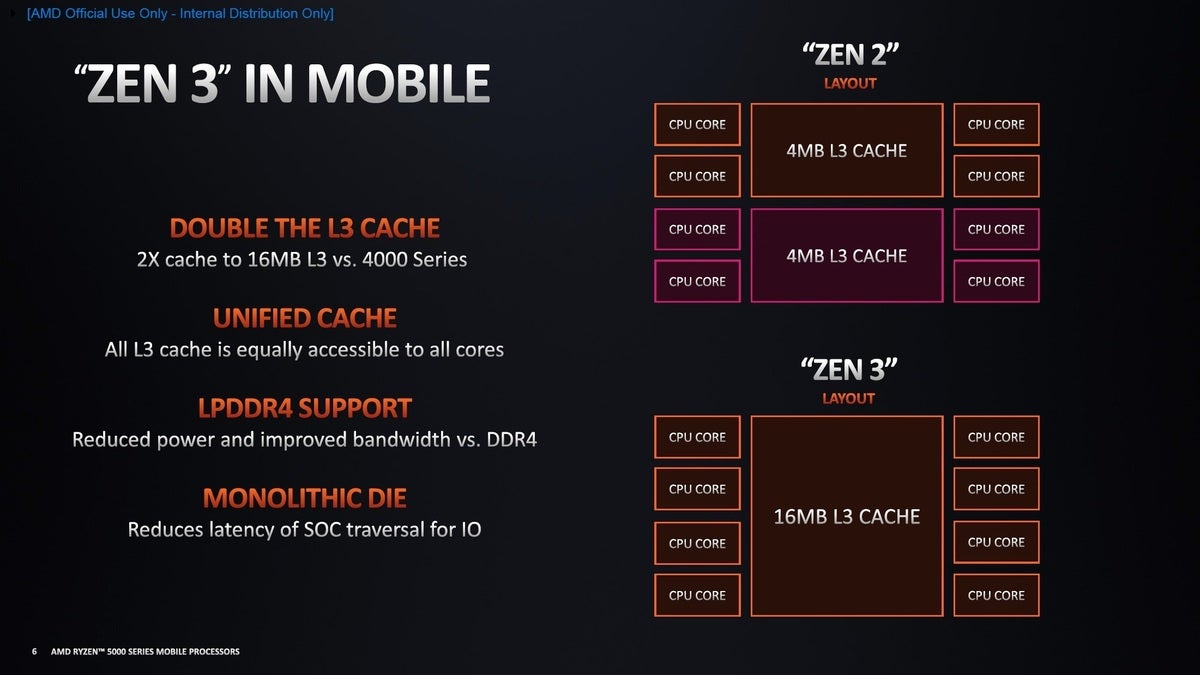 AMD
AMDThe H-class of Ryzen 5000 mobile processors are all based on AMD’s 7nm Zen 3 microarchitecture.
The lineup: Tiger Lake H and Ryzen 5000 mobile processors
Five Tiger Lake H processors will be found in upcoming consumer laptops. (Five Tiger Lake H processors for commercial laptops will launch as well—we have more details on those in our full overview of Tiger Lake H.) These range from the beefy Core i9-11980HK with 8 cores, 16 threads, and a 65W TDP, all the way down to the more budget-friendly Core i5-11260H with 6 cores, 12 threads, and a 45W TDP. The 45W TDP chips ostensibly are 35W chips capable of using more power, as they’re also listed with a set of lower base clocks at a “config TDP” of 35W.
As always, actual performance will vary from laptop to laptop, because other factors like size and panel type influence the overall experience. Expect to see different benchmark results based on the focus (i.e., gaming vs. content creation) of the specific model.
Tiger Lake H consumer processor lineup:
- Core i9-11980HK (8 cores / 16 threads): Max boost 5.0GHz, 3.3GHz at config TDP of 65W
- Core i9-11900H (8 cores / 16 threads): Max boost 4.9GHz, 2.5GHz at 45W TDP
- Core i7-11800H (8 cores / 16 threads): Max boost 4.6GHz, 2.3GHz at 45W TDP
- Core i5-11400H (6 cores / 12 threads): Max boost 4.5GHz, 2.7GHz at 45W TDP
- Core i5-11260H (6 cores / 12 threads): Max boost 4.4GHz, 2.6GHz at 45W TDP
(For full specs, see the chart image below.)
Intel has promised 80 laptop designs featuring Tiger Lake H, with Acer, Asus, Dell, Gigabyte, HP, Lenovo, MSI, and Razer named as partners. These notebooks target gamers and creators, with features like slim-bezel 17-inch screens, 1080p 360Hz panels, 1440p displays, and resizeable bar support teased. Ultraportable models will be available as well.
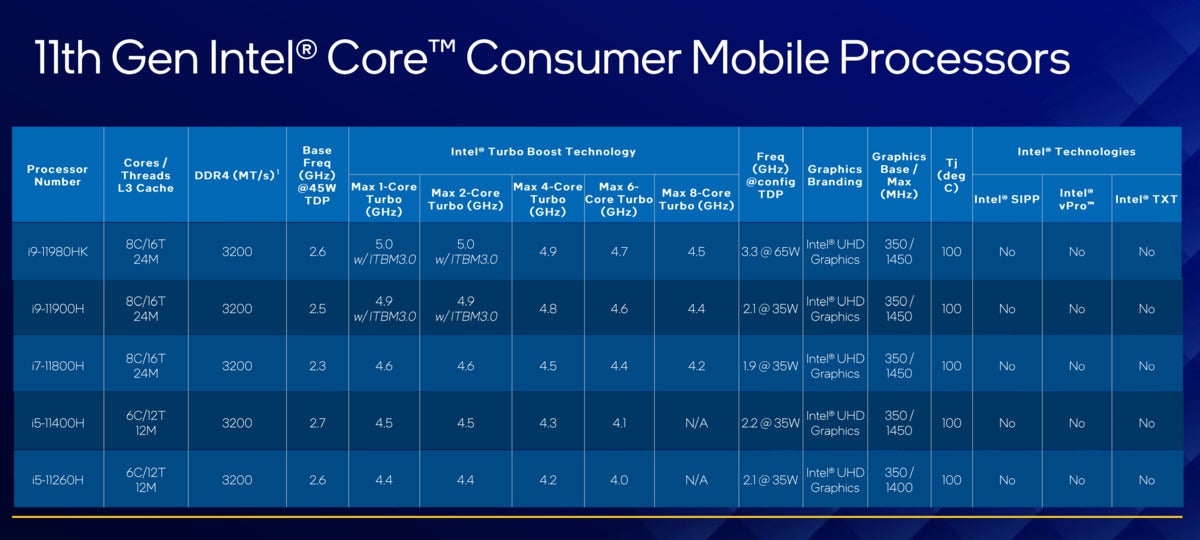 Intel
IntelWith three more processors in its lineup of H-class parts, Ryzen 5000 mobile is more complicated, as it spans HS, H, and HX variants. HS models are lower-wattage parts with lower base clocks, designed for ultraportable laptops; H models have higher clock speeds and a 45W TDP; and HX processors boast the highest speeds and have a flexible “45W+” TDP. Only the HX processors are unlocked for overclocking.
Ryzen 5000 mobile processor lineup:
- Ryzen 9 5980HX (8 cores, 16 threads): Max boost 4.8GHz, base clock 3.3GHz, 45W+ TDP
- Ryzen 9 5900HX (8 cores, 16 threads): Max boost 4.6GHz, base clock 3.3GHz, 45W+ TDP
- Ryzen 7 5800H (8 cores, 16 threads): Max boost 4.4GHz, base clock 3.2GHz, 45W TDP
- Ryzen 5 5600H (6 cores, 12 threads): Max boost 4.2GHz, base clock 3.3GHz, 45W TDP
- Ryzen 9 5980HS (8 cores, 16 threads): Max boost 4.8GHz, base clock 3.0GHz, 35W
- Ryzen 9 5900HS (8 cores, 16 threads): Max boost 4.6GHz, base clock 3.0GHz, 35W TDP
- Ryzen 7 5800HS (8 cores, 16 threads): Max boost 4.4GHz, base clock 2.8GHz, 35W TDP
- Ryzen 5 5600HS (6 cores, 12 threads): Max boost 4.2GHz, base clock 3.0GHz, 35W TDP
(For full specs, see the chart image below.)
Like Tiger Lake H, most laptops featuring Ryzen 5000 mobile H-class processors focus on gaming or content creation. A few have particularly unique approaches, like the Asus ROG Flow X13 and its eGPU accessory. However, availability has been limited, due to a rolling launch of models and high demand. Not all processors can even be found in the wild yet—the highest-end chip you can currently get your hands on is the 5900HX. Intel says that it’ll have over a million processors shipped by launch, so on this point, the shortages plaguing AMD may come to haunt it further.
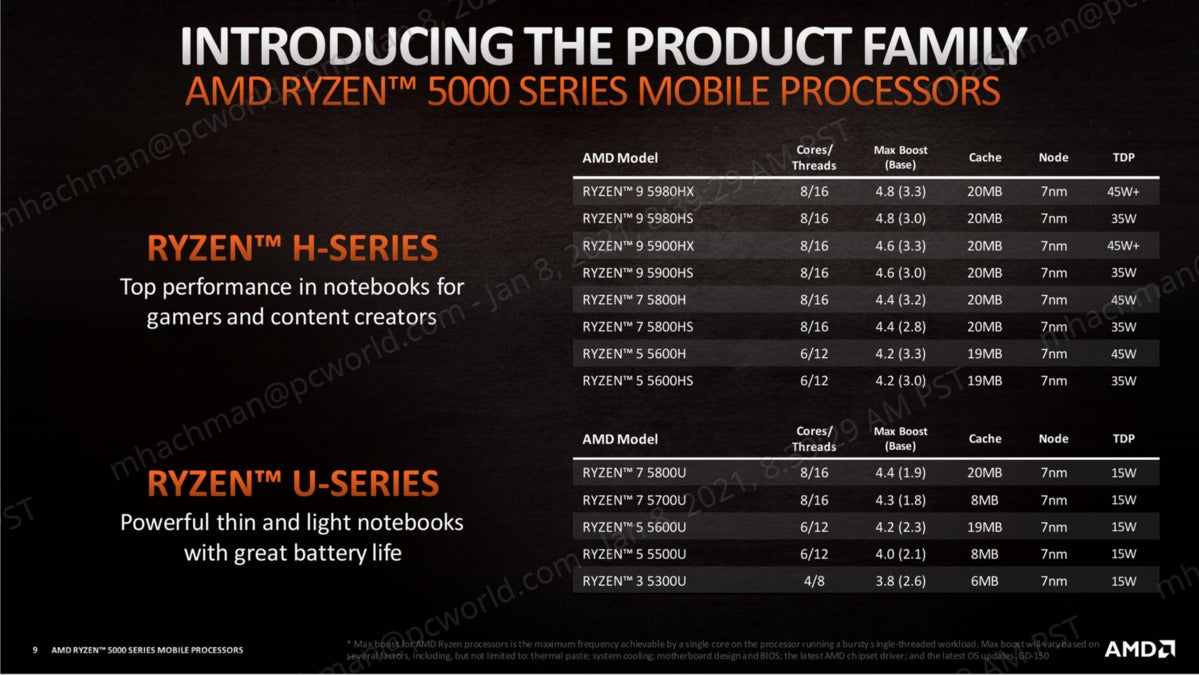 AMD
AMDPerformance
Currently, we only know half the story on performance for this face-off. Ryzen 5000 mobile processors dazzled us back in late January, providing a solid 10- to 12-percent improvement over Ryzen 4000. It also handily trounced Intel’s 10th-gen Comet Lake H chips by whopping 20 percent in single-threaded tasks and an average of 18 percent for multi-threaded tasks. (You can see the full details in our review of Ryzen 5000 mobile.)
Of course, Comet Lake H was all that Intel had available for comparison when Ryzen 5000 mobile launched. Now that Tiger Lake H is here, Intel claims that AMD will have to take a step down the podium to second place. The company says we’ll see a 19-percent performance increase moving from 10th-gen to 11th-gen chips, with its top-tier Core i9-11980HK beating AMD’s Ryzen 9 5900HX—the top available competing chip—by as much as 26 percent in gaming. Even more interesting is the assertion that the Core i5-11400H can generally go toe-to-toe with the Ryzen 9 5900HS, winning in some games, ending in a draw in others, and losing by a minimal amount in the rest.
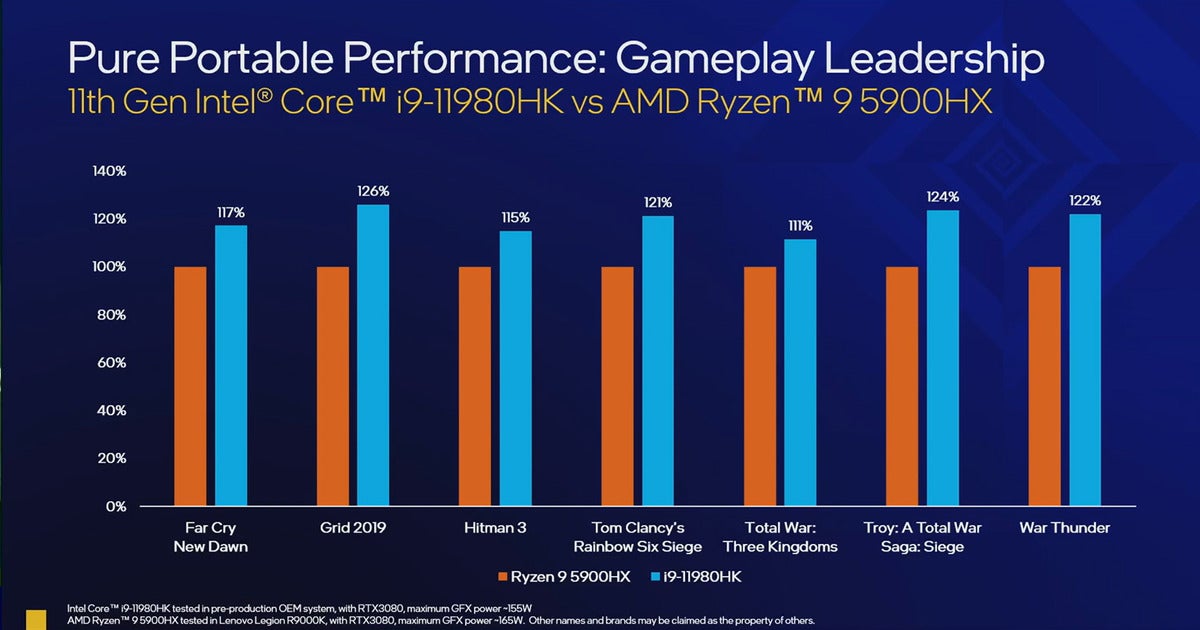 Intel
IntelIntel claims that its top-tier Tiger Lake H processor can outperform AMD’s current available best by up to 26 percent.
No one will know how this ultimately shakes out until independent benchmarks (such as our own) are complete. But as you can see from this announcement, Intel implies that it’ll soon reclaim its former reputation for superior gaming performance.
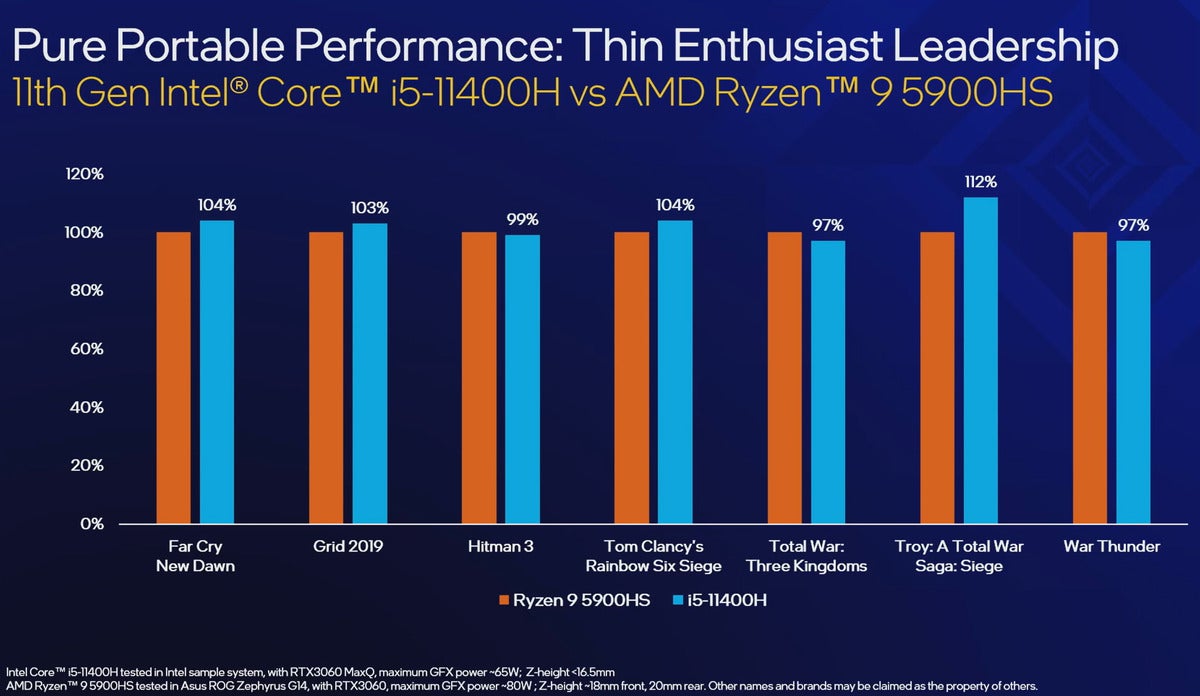 Intel
IntelMore astonishing is Intel’s assertion that its Core i5 Tiger Lake H chip can match the performance of a 35W Ryzen 9 mobile CPU.
Who’s on top?
Without hard performance data, calling a winner in this showdown would be premature—unless the forecast names consumers as the victor in this tug of war. Shortages of most things tech has plagued everyone over the past year. If Intel can put hardware in hands, tech-starved buyers will benefit. Intel won’t even need to thrash AMD when it comes to performance, either. Just tracking closely will be enough, and good laptop designs from partners will deliver the rest.
Note: When you purchase something after clicking links in our articles, we may earn a small commission. Read our affiliate link policy for more details.


